How to Make a Basic Vanilla Cake
This post may contain affiliate links. Read the full disclosure here.
This made from scratch Basic Vanilla Cake recipe is one that must be added to your repertoire. It’s light, tender, and full of vanilla flavor. The buttery, moist texture makes it a great cake for all occasions.
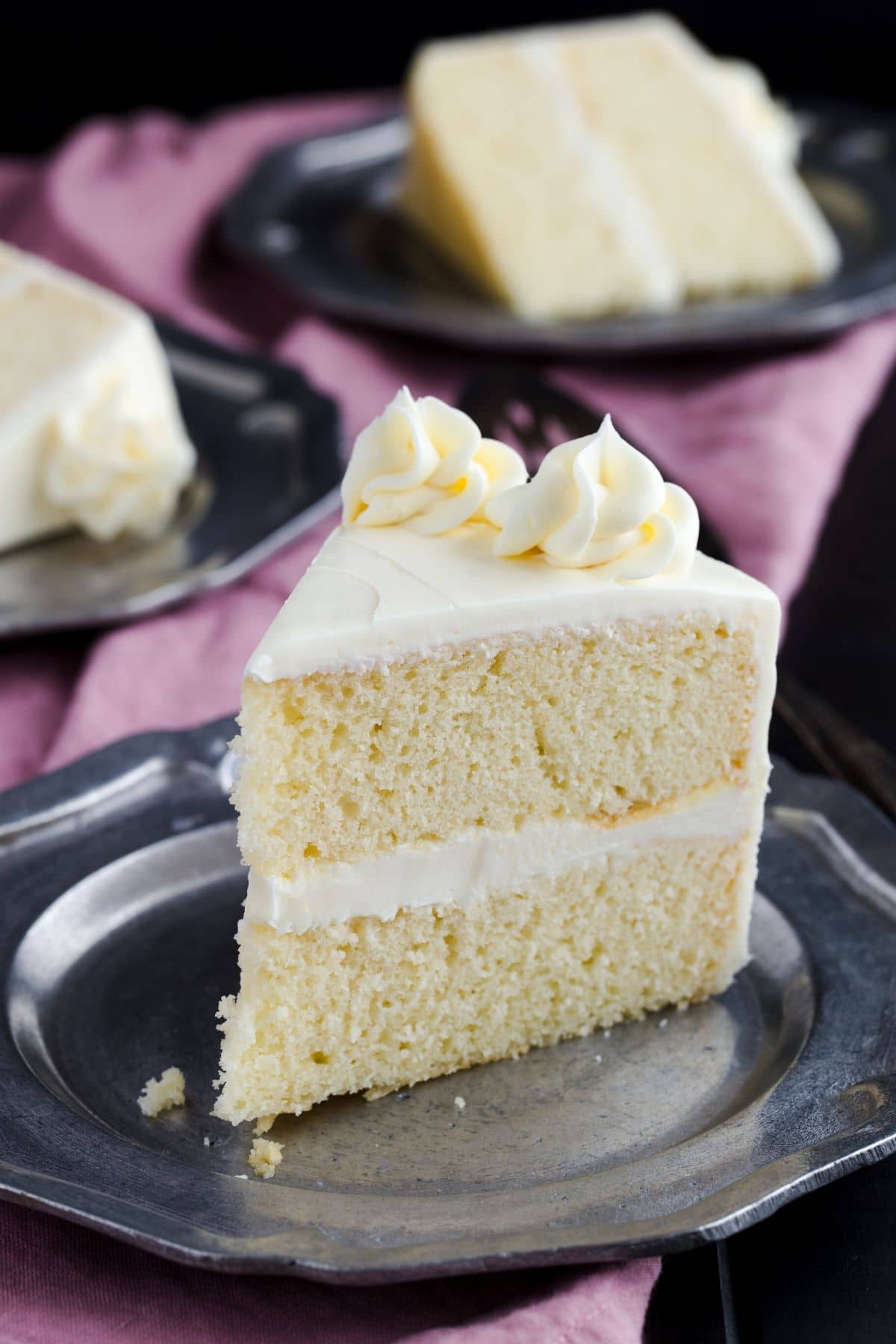
I’ve been on the hunt for a great vanilla cake recipe that I can use over and over again. I tried many and never found one that was wonderful enough to claim a spot on my blog until now.
If you like this version, you may also want to try my vanilla cupcakes and moist white cake recipe. It uses only egg whites instead of whole eggs. Or my mug cake version, madeleines, and cake pops for single and bite-sized servings! Or my chocolate cake if you’d love a chocolate version.
This is the same recipe I used in my “how to make the perfect cake” post. Make sure you follow all the tips I give you in that post to ensure great results every time.
The recipe starts by creaming the butter and sugar together and then adding the eggs. Once that is mixed together well, the flour is added followed by the milk.
The process is easy to remember which makes this simple vanilla cake easy to make. And I’m certain you are going to agree that this is the best vanilla cake recipe!
Why this basic vanilla cake recipe works
- This easy vanilla cake recipe uses the 1-2-3-4 method which is from the 19th century. It’s an easy method to remember the ratio of ingredients. 1 cup of butter, 2 cups of sugar, 3 cups of flour, and 4 eggs.
- I adjusted these quantities slightly to achieve the texture I was looking for. I used half a cup less sugar and a fourth cup less flour. This gave me a lighter cake that isn’t overly sweet.
- Cake flour is used for a fine crumb and delicate cake texture.
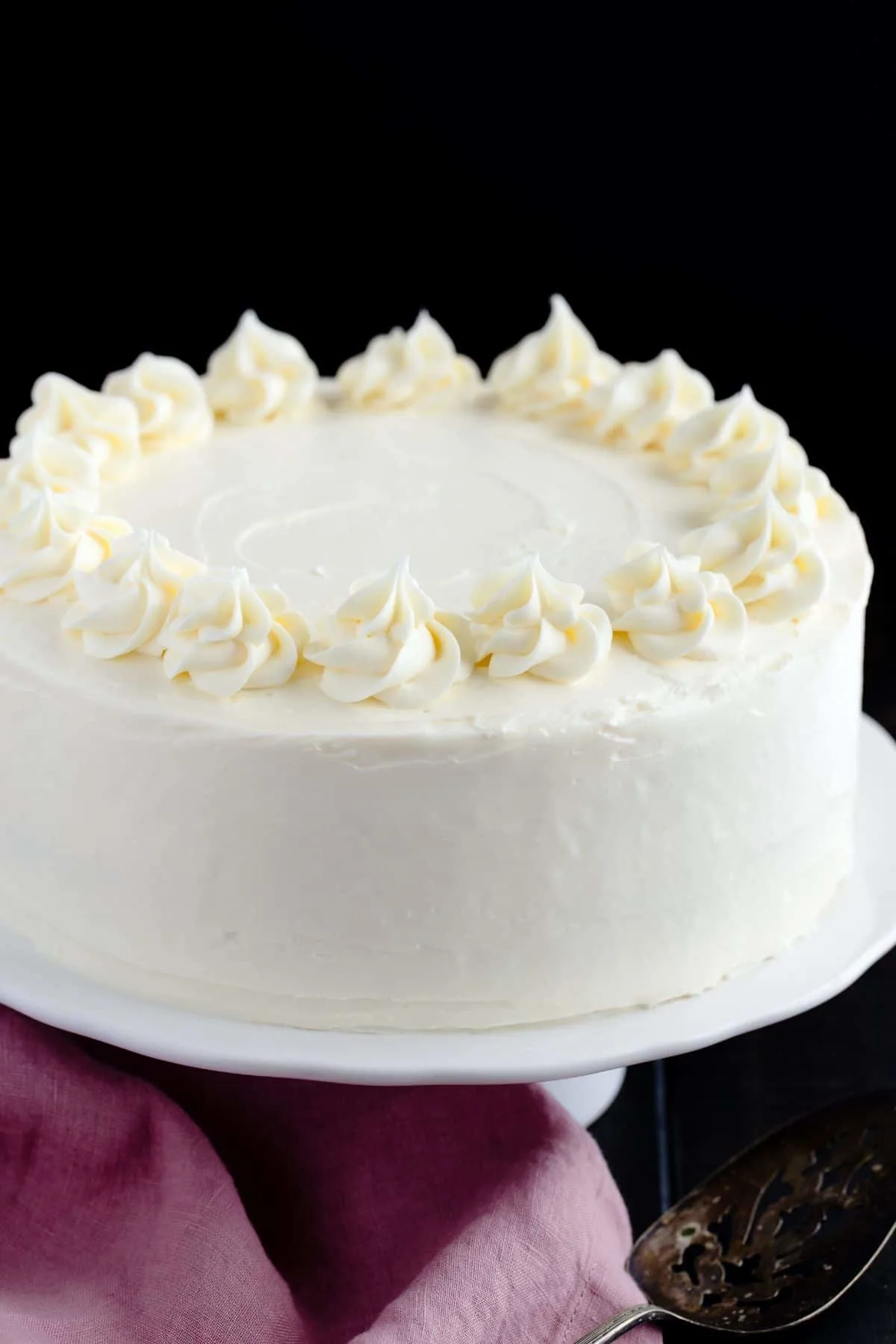
Vanilla cake ingredients
As mentioned above, this cake uses standard pantry ingredients. But choosing quality ingredients is key to a great tasting cake with the best texture. Let’s go over those ingredients in detail.
- Butter: Unsalted butter that is softened to room temperature will cream perfectly with the sugar.
- Sugar: Granulated white sugar is what works best.
- Eggs: I use 4 whole eggs in my cake recipes.
- Vanilla: Look for high-quality vanilla to use. I prefer Nielsen-Massey Madagascar Bourbon Pure Vanilla or you can make your own vanilla.
- Flour: Bob’s Red Mill Super Fine Cake Flour is the best and will ensure the cake has the best texture.
- Leavening: Baking powder is used to give the cake rise.
- Salt: Salt helps to balance the sweetness.
- Milk: Whole milk works best but you can also use buttermilk.
How do you make a cake from scratch?
Making a cake at home is incredibly easy! This recipe uses the creaming method to emulsify the ingredients. This also incorporates air to give the cake a light and fluffy texture.
The Batter – It’s important to set the cold ingredients out for about 1 hour before you begin. The butter, eggs, and milk must be at room temperature in order for them to blend together properly.
The Frosting – The frosting is my very favorite basic vanilla buttercream. I have a dedicated post for the frosting. Be sure to pop over and read all my tips for silky smooth frosting that isn’t overly sweet tasting.
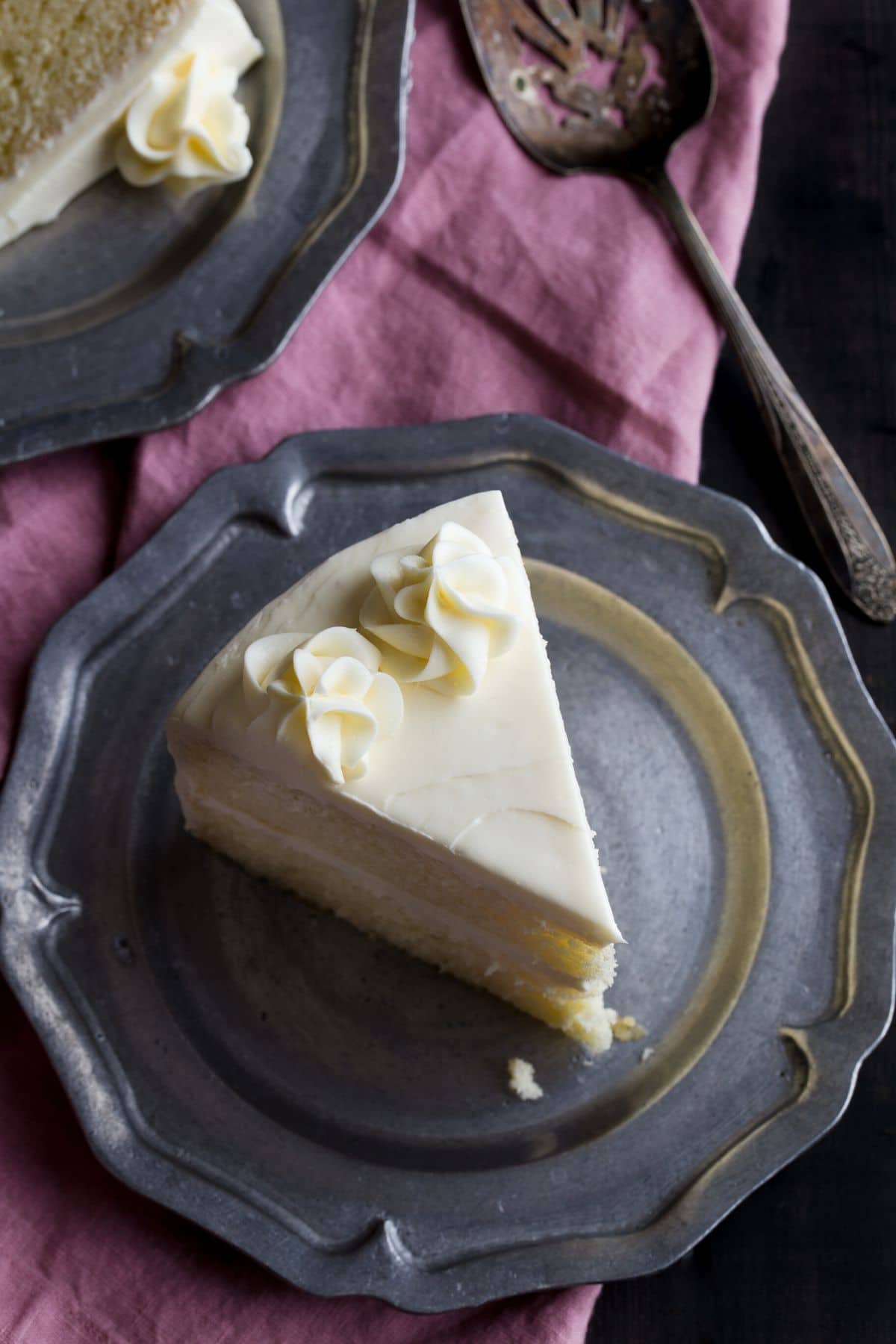
Step 1: Gather the ingredients and preheat the oven
It is essential to use butter, eggs, and milk that are at room temperature. Room temperature ingredients will combine more easily, giving you a properly emulsified batter.
Set the butter, eggs, and milk out on the counter 1 hour before you plan to make the cake. Measure out all the other ingredients and have them ready to use.
Prepare your stand mixer with the paddle attachment or handheld mixer with beaters. Lightly grease and flour two 9-inch round cake pans and line the bottoms with parchment paper. Preheat the oven about 30 minutes before you begin making the batter.
Step 2: Cream the butter and sugar together
The butter must be room temperature in order for it to cream properly with the sugars. This is why it is so important to set it out 1 hour ahead of time.
Use a stand mixer fitted with the paddle attachment to beat the butter and sugar together. You’re looking for a light and fluffy texture.
It should appear lighter in color and double the sized in volume once it has been creamed properly. This can take 5 to 10 minutes.
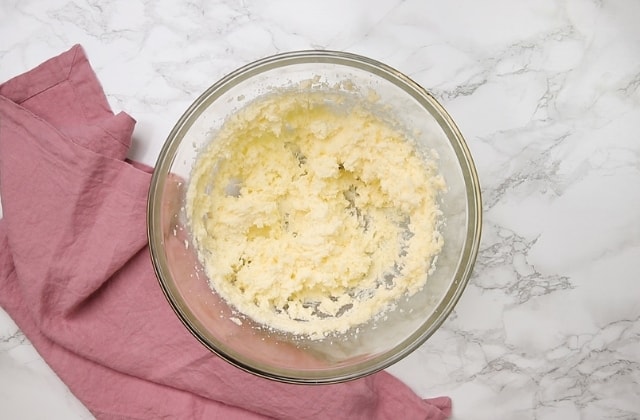
Step 3: Add the eggs and vanilla
Make sure the eggs are at room temperature or they’ll cause the batter to curdle.
Add one egg at a time and beat the batter well after each addition. Then beat in the vanilla extract.
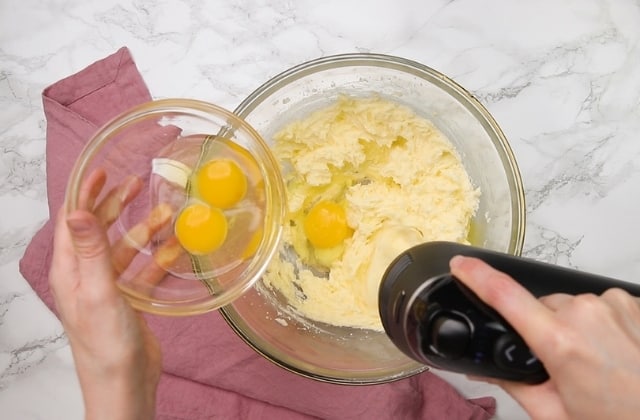
Step 4: Add the dry ingredients
In a small bowl, combine the flour, baking powder, and salt. Use a whisk to stir everything together well.
Sift the flour mixture into the butter mixer. This will remove any lumps from the cake flour so it incorporates into the batter.
With the mixer on low speed gradually pour in the milk. Continue to beat the batter just until all the flour is incorporated. Take extra care to not overmix.
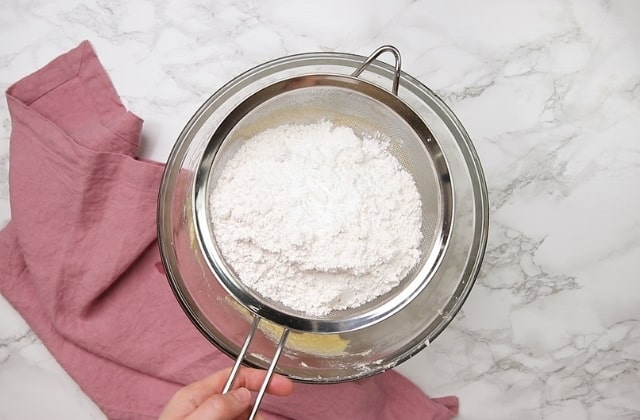
Step 5: Bake the cake
Divide the cake batter evenly between the two pans. Bake the cake for 20-30 minutes. Just until a toothpick inserted into the center comes out with only a few moist crumbs attached.
I suggest starting to check for doneness at around 15 minutes since ovens can vary in temperature.
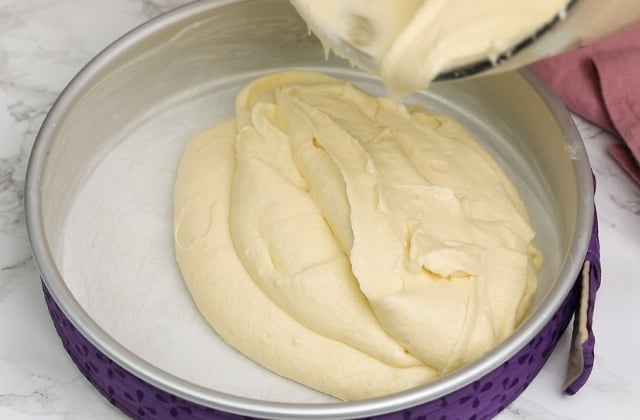
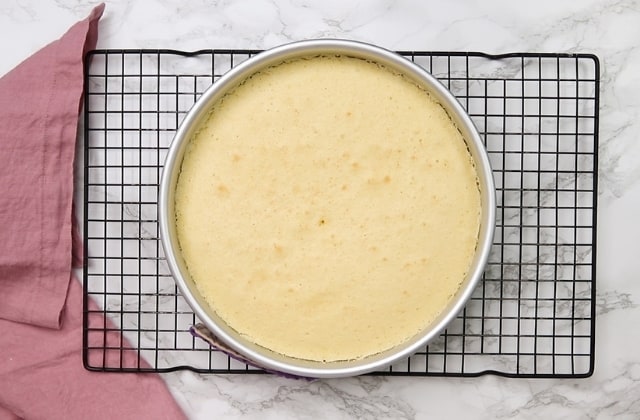
Cool the cake layers in the pan for 10 minutes then invert them onto a wire rack to cool completely. Once cooled, make the frosting and frost the cake.
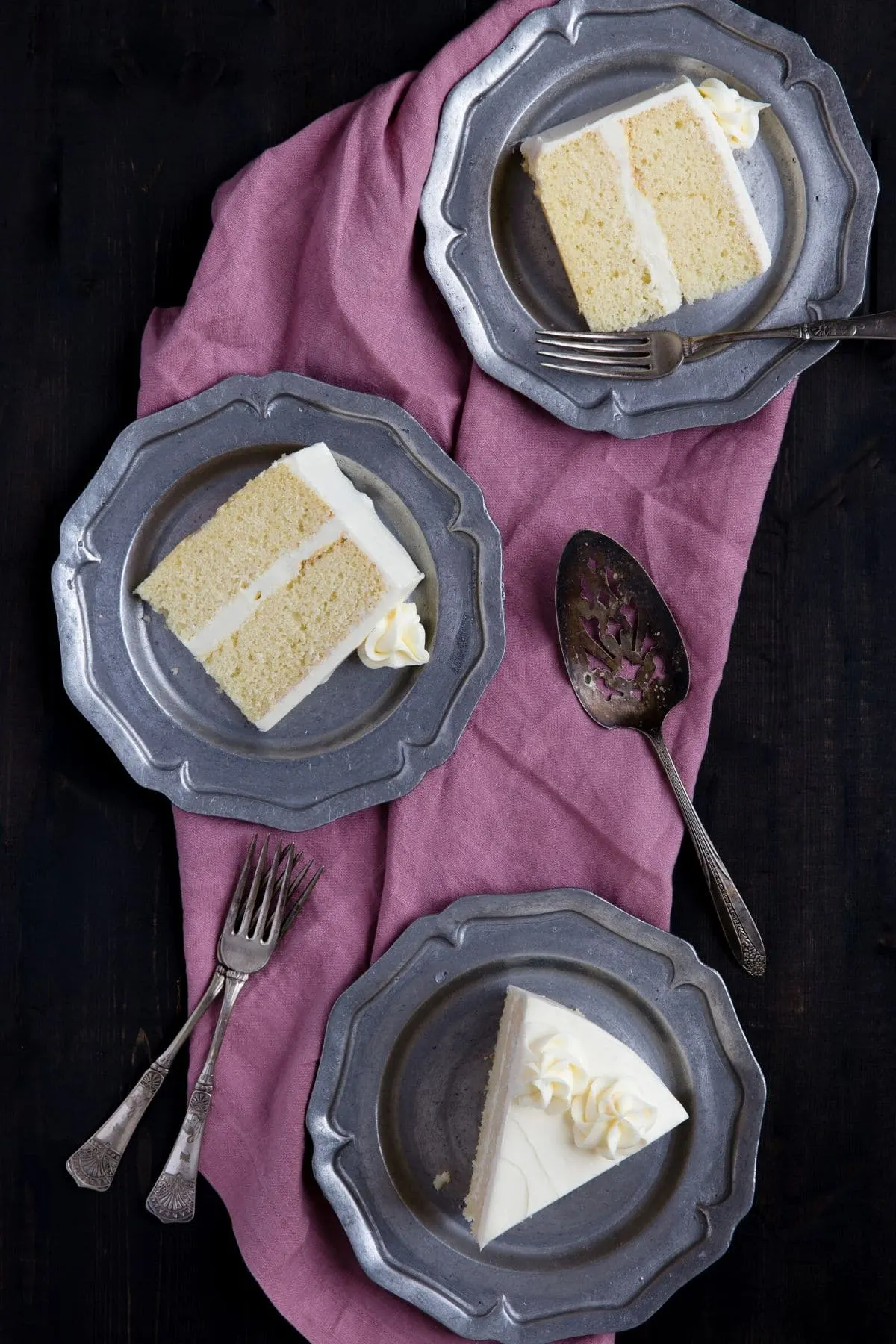
Vanilla Cake FAQ’s
Can I bake this cake in 3 8-inch round pans instead of 2 9-inch pans?
Yes, you certainly can. The recipe yields enough batter to fill 2 9-inch pans, 3 8-inch pans, or 24 muffin cups.
The bake time will vary slightly. Start checking the cakes about 5-7 minutes sooner than the time listed in the recipe.
How do I adjust the recipe for it to work at high elevation?
I have zero experience baking at high altitudes so I don’t feel comfortable giving advice for this. However, a reader who lives 5,000 feet above sea level made the following changes:
- 3 cups sifted cake flour
- 4 large eggs
- 1-¼ cups whole milk
- 2 teaspoons baking powder
- 1 teaspoon salt
All the other ingredients listed in the recipe stayed at the same amounts. Baked in 2 8-inch round cake pans at 375°F for 25 minutes.
She said the cake was delicious and has already been requested to be made again.
How do I make a cake more moist?
First, make sure you’ve followed all my tips on how to make the perfect cake. Second, keep a close eye on it during baking. Check it with a wooden toothpick.
- If the toothpick comes out with wet batter on it, it needs more baking time.
- If the toothpick comes out with a few dry crumbs, it is perfectly baked and needs to be removed from the oven.
- If the toothpick comes out completely clean, it has baked too long and will result in a dry cake.
Start checking the cake about 5-7 minutes before the suggested bake time.
If you like this basic vanilla cake recipe, try these others:
- Birthday Cake
- Marble Cake
- Lemon Raspberry Cake
- Lemon Blueberry Bundt Cake
- Effortless Angel’s Food Cake
Basic Vanilla Cake Recipe
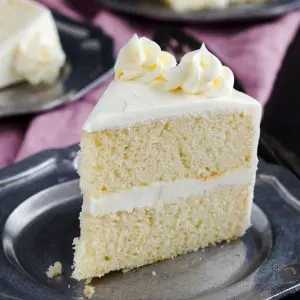
Ingredients
For the cake
- 1 cup (226 g) unsalted butter, softened
- 1 ½ cups (300 g) granulated sugar
- 4 large eggs, room temperature
- 1 tablespoon vanilla extract
- 2 ¾ cups (330 g) cake flour
- 2 ¾ teaspoons baking powder
- ½ teaspoon salt
- 1 cup (240 ml) whole milk, room temperature
For the frosting
- 1 ½ cups (339 g) unsalted butter, softened
- 5 ½ cups (660 g) confectioners' sugar, sifted
- 1 tablespoon vanilla extract
- ¼ teaspoon salt
- 6 tablespoons heavy cream, room temperature
Instructions
Make the cake
- Preheat the oven to 350°F. Lightly grease the sides and bottom of 2 9-inch round cake pans. Line the bottoms with parchment paper cut to fit and generously grease the parchment paper as well. Dust the pans with flour then tap out any excess; set aside.
- In a large bowl, beat the butter and sugar together until light and fluffy, about 5 minutes. Add the eggs, one at a time, mixing well after each addition. Beat in the vanilla.
- Combine the flour, baking powder, and salt in a medium bowl. Stir with a whisk and add it to the butter mixture followed by the milk. Beat on medium-low speed just until combined.
- Divide the batter evenly between the prepared pans. Bake for 20-30 minutes or until a toothpick inserted into the center comes out with few moist crumbs attached. Take care to not over-bake. Check the cake at 15 minutes to see how it is doing and judge the timing from there.
- Cool for 10 minutes. Remove from pans and cool completely on a wire rack.
Make the frosting
- In the bowl of a stand mixer fitted with the paddle attachment or a large mixing bowl with a handheld electric mixer, beat the butter on medium-high speed until creamy and pale in color, about 5 minutes.
- Add half the confectioners’ sugar and beat on low speed just until the sugar has fully moistened, then turn the speed up to medium-high and beat until well incorporated, about 3-5 minutes.
- Add the remaining confectioners’ sugar and beat on low speed just until the sugar has fully moistened, then turn the speed up to medium-high and beat until well incorporated, about 3-5 minutes.
- Add the vanilla and salt. Turn the mixer on low speed and slowly add 3 tablespoons of the heavy cream. Turn the mixer up to medium-high and beat until the cream is well incorporated, about 3-5 minutes. (After 2 minutes stop and scrape down the sides and bottom of the bowl then continue mixing.)
- Check the consistency of the frosting and add more cream, ½ tablespoon at a time, if needed. The frosting should be soft and spreadable but not so loose that it doesn’t hold its shape.
Assemble the cake
- Place one layer on a serving platter. Spread about ⅓ of the frosting over the top.
- Gently place the second layer on top of the frosting. Spread remaining frosting over the top and sides of the cake.
Notes
- Cake flour: Cake flour is finer and will produce a tender soft tender crumb. The recipe was formulated to use this flour. The results will not be as intended if all-purpose flour is used. You can use my homemade cake flour instead.
- Room temperature ingredients: Make sure to use room temperature ingredients. Cold eggs will be difficult to thoroughly mix in and will cause the cake to be dense.
- Properly measure: Measure the flour by lightly spooning it into the measuring cup then level the cup with the back of a knife. Or use the weight measurements.
- Don’t overbake: Start checking the cake 5-7 minutes sooner than the bake time listed. Insert a toothpick into the center of the cake to test for doneness.
- If the toothpick comes out with wet batter on it, it needs more baking time.
- If the toothpick comes out with a few moist crumbs on it, it’s perfectly baked and needs to be removed from the oven.
- If the toothpick comes out completely clean, I’m sorry to say, you’ve overbaked the cake and it will be dry.
- Bake the cake in 3 8-inch round pans for 15-25 minutes, 2 12-cup muffin pans for 15-18 minutes, or a 9×13-inch pan for 30-35 minutes. If you wish to make changes other than these, please consult this guide for how to convert pan sizes.
- You can change the flavor of the cake by adding your favorite extract or essence.
- This cake can be transformed into a Moist White Cake by using egg whites instead of whole eggs.
- Wrap baked and cooled cake layers tightly in plastic wrap and store them in the refrigerator. Assemble and frost the cake within 2 days.
- Or layers can be triple wrapped in plastic wrap and frozen for up to 2 weeks. Leave wrapped and set on the counter to thaw slightly before use.
- The frosting will keep for up to 2 weeks stored in the refrigerator in an airtight container. You must let the buttercream come to room temperature by setting it out on the counter for a couple of hours, then beat it with an electric mixer if needed.
- Once the cake has been assembled, cover it and keep it stored in the refrigerator for up to three days. Bring it to room temperature just before serving.
- The frosted cake can be frozen for up to 2 months. Thaw it overnight in the refrigerator and let it come to room temperature just before serving.
Nutrition
The nutrition information provided is for convenience and as a courtesy only. It is not guaranteed to be accurate because nutrition information can vary for a variety of reasons. For precise nutritional data use your preferred nutrition calculator and input the exact ingredients and brands you used in the recipe.
Adapted from Bigger Bolder Baking.

I don’t have unsalted butter on hand and was wondering if it would work to just use regular butter. Do you have any idea?
The downfall with salted butter is you have no idea how much salt is in the butter. Your cake could end up being super salty.
I never have unsalted butter on hand when I bake and I use regular salted butter instead all the time and just leave out the salt in the recipe and it comes out perfect.
Would this cake be suitable for a two-tiered cake? My plan is the first tier being 8″ and the second tier 6″, and I intend to use dowels to hold up the second tier. I also plan on using fondant. I need a cake that is firm and moist, but not so soft it might compress under the weight of the fondant.
I think it would great for a tiered cake!
Thanks, I’ll give it a shot!
Did you try it with fondant? How was it? Did it hold the fondant?
I have no experience working with fondant so I’m not sure if it will work or not. I’m sorry, I wish I could be more helpful.
I made it with fondant and it holds the fondant perfectly i wish i could share the picture of the cake here. It came out lovely. Great Recipe! I’ll be using it for years to come.
Thanks Jen
I did end up making this cake with the fondant. I used a simple vanilla buttercream as a crumb-coat, then covered the whole thing in fondant. It worked BEAUTIFULLY! I also made a smaller tier for the cake. the crumb of the cake is firm enough to support the fondant, but it is still a moist cake with a great flavour. I’m linking to my Facebook post about the cake. Lol! Not exactly a professional job, but it came out well. Too bad I got too tired to finish it. She loved it anyway. 🙂
Can you substitute oil for the butter, or smart balance instead of butter? I tried using smart balance with another cake I made and it came out dense. So, I was wondering if that would happen if I used oil or smart balance with your recipe.
I’ve never used smart balance and have no idea how it will turn out in the recipe. I don’t recommend oil because it’s flavorless.
How would you adjust coooking time for cupcakes?
Cupcakes may need 3-5 minutes less cook time than the recipe calls for. I would start checking for doneness when you have about 10 minutes remaining.
I would like to make this cake for my husband’s birthday. I just don’t understand the part where you have to refrigerate the cake after baking it? Is this a recipe that requires to be made several days before being served? Thanks in Advance
Some people like to make desserts ahead of time when they are planning for an event or hosting a party. That is why I offered tips for making the cake ahead. If this does not apply to you, simply ignore the “make ahead tips’ section of the recipe.
Thanks I’m going to make this tonight!!!!!
Enjoy!
So Pleased to have found a basic vanilla cake recipe . I am definitely going to try it out
So Pleased to have found a basic vanilla cake recipe . I am definitely going to try it out
looks like the perfect vanilla cake Jen, such a keeper recipe!
Thanks, Manali! We really enjoyed it!
I love vanilla cake!! I must have one ?
I love vanilla cake!! I must have one ?